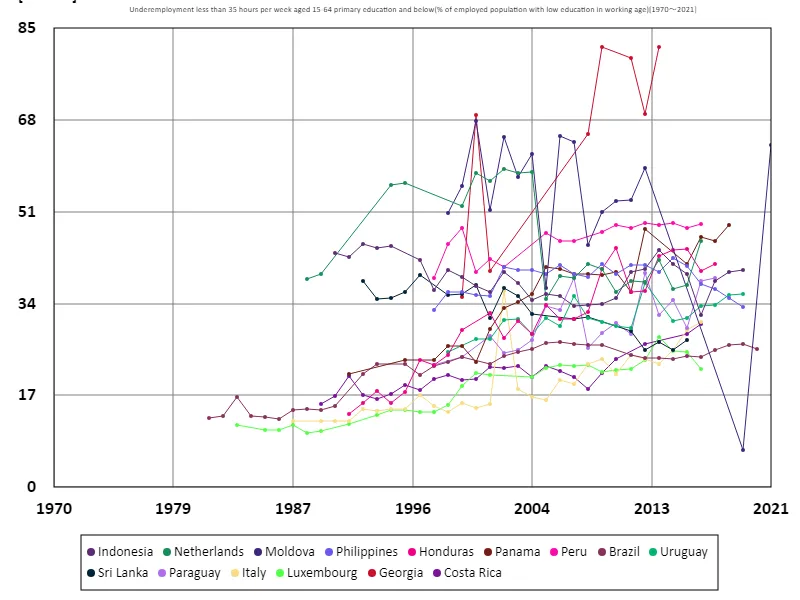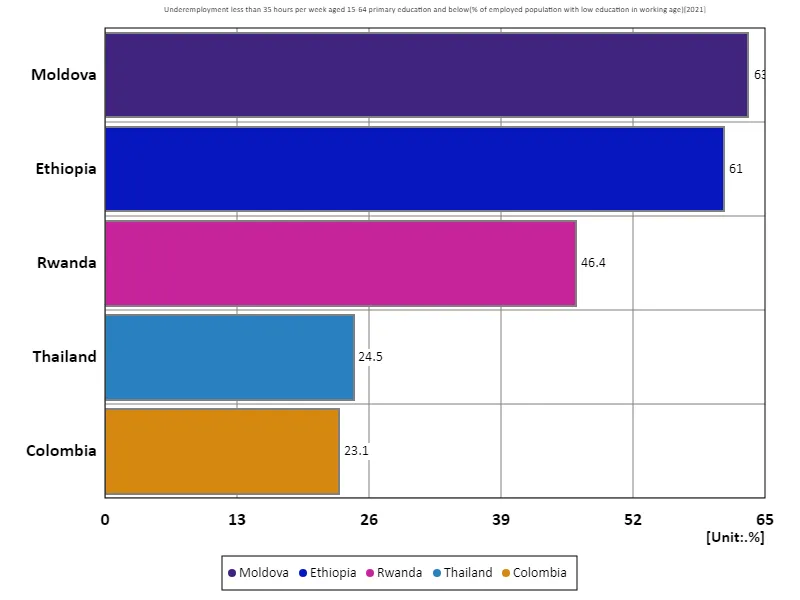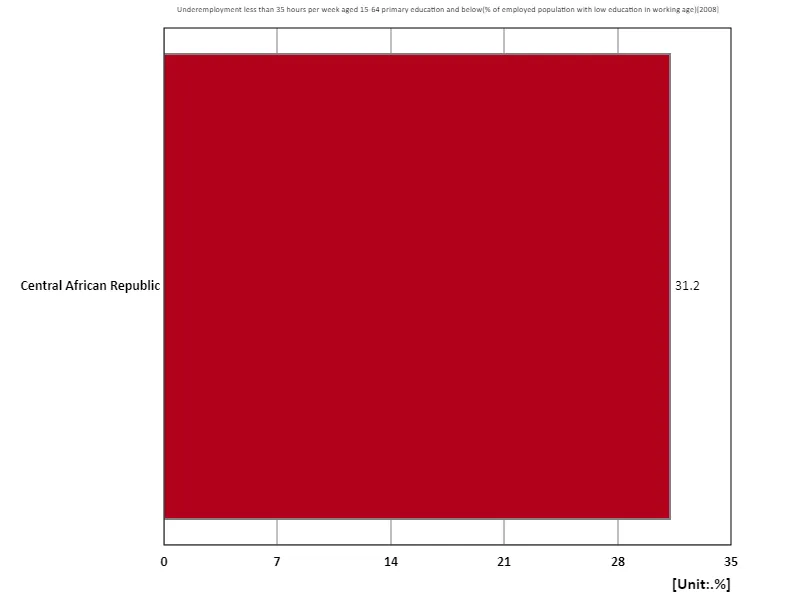- Abstract
- Ages 15-64, underemployed less than 35 hours per week, with primary school education or less (% of working-age population with primary school education)
- Ages 15-64, underemployed less than 35 hours per week, with less than primary education (percentage of working-age population with primary education) (Worldwide)
- Ages 15-64, underemployed less than 35 hours per week, with primary education or less (% of working-age population with primary education) (World, latest year)
- Ages 15-64, underemployed less than 35 hours per week, with primary education or less (% of working-age population with primary education) (region, latest year)
- Reference
Abstract
Data for 2021, showing that underemployment among 15-64 year olds in Moldova reached 63.4%, highlights the structural challenges in the economy. This situation, especially with a large proportion of workers with primary school education or below, points to an imbalance in the labor market. In recent years, particularly in Eastern Europe and Latin America, there have been many cases where the quality of employment has not improved despite the progress made in spreading education. In these regions, insufficient economic growth has led to an oversupply of labour and a shortage of jobs, especially low-skilled ones. In addition, the impact of COVID-19 has led to an increase in non-regular and part-time employment, further exacerbating existing challenges. In many countries, workers are finding it harder to find stable employment, leading to a decline in their quality of life. Moreover, insufficient investment in education and training limits opportunities for workers to upgrade their skills. To address this situation, governments and businesses need to work together to improve education systems and vocational training programs. It is also important to review employment policies and develop new industries. The example of Moldova is an important case that should serve as a lesson for other countries.
Ages 15-64, underemployed less than 35 hours per week, with primary school education or less (% of working-age population with primary school education)
Looking at data from 1981 to 2021, South Korea’s underemployment rate for those working less than 35 hours has decreased significantly, from 100% in 2009 to 27.1% today. This rapid change can be seen as the result of the maturation of the labor market along with economic growth, leading to improvements in worker skills and an expansion of regular employment. In particular, rising educational standards have had a positive impact on the labour market, with many young people now having primary school or higher qualifications. Meanwhile, overall underemployment trends highlight particular challenges in countries with large numbers of low-skilled workers. These countries tend to experience chronic underemployment because their education systems are weak and workers lack the skills the market demands. Furthermore, as industrial structure changes due to changes in the global economy and technological innovation, there is an urgent need to retrain workers. Against this background, countries need to review their education systems and employment policies to create an environment in which workers can find stable jobs. The Korean case serves as an important reference point for labor market reforms in other countries.


The maximum is 100%[2009] of Korea, and the current value is about 27.1%
Ages 15-64, underemployed less than 35 hours per week, with less than primary education (percentage of working-age population with primary education) (Worldwide)
Analysing data from 1981 to 2021, South Korea’s underemployment rate for those working less than 35 hours has fallen dramatically from 100% in 2009 to 27.1% today. This change is due to economic growth and the spread of education, particularly the decline in the proportion of workers with primary school education or less. South Korea has increased investment in education and developed a skilled workforce, resulting in a more stable employment environment. Meanwhile, in countries with large numbers of low-skilled workers, inadequate education perpetuates underemployment. In particular, as the economy becomes increasingly digitalized and automated, these workers are at greater risk of losing their jobs, making reskilling even more important. Countries need to reform their employment policies and education systems to improve the skills of their workers. In this way, the Korean case can serve as a model for other countries and reaffirms the importance of labor market flexibility and education. In order to continue supporting sustainable economic growth, it is essential to take steps to improve the quality of the workforce.


The maximum is the latest one, 81.5% of Georgia
Ages 15-64, underemployed less than 35 hours per week, with primary education or less (% of working-age population with primary education) (World, latest year)
In 2021 data, Moldova’s underemployment rate of less than 35 hours reached 63.4%, significantly higher than the global average of 43.7%. This high underemployment rate reflects economic fragility and poor quality of jobs, especially as workers have a high proportion of those with primary school education or less. In countries like Moldova, workers face difficulties finding stable employment due to an unstable labour market and the prevalence of low-skilled jobs. This trend is being replicated in other low- and middle-income countries, raising concerns that long-term underemployment will continue unless universal education is improved. In addition, the impact of COVID-19 has led to an increase in part-time employment, making the situation for non-regular workers even more difficult. To address this issue, governments and businesses need to work together to improve education and vocational training. After all, improving worker skills and improving the quality of jobs are essential for sustainable economic growth. Moldova’s case offers important lessons for other countries to understand the challenges they face and to develop effective policies.


The maximum is 63.4% of Moldova, the average is 43.7%, and the total is 218%
Ages 15-64, underemployed less than 35 hours per week, with primary education or less (% of working-age population with primary education) (region, latest year)
Data for 2008 show that the rate of underemployment (less than 35 hours) reaches 31.2% in the Central African Republic, a unique situation as the average and total figures are the same. This figure is an indicator of economic instability and poor quality of employment, especially as many workers have a primary school education or below and there is a lack of vocational training. In countries like the Central African Republic, social instability and weak infrastructure hinder the functioning of labour markets. As a result, many workers are underemployed and find it difficult to earn a stable income. There is an urgent need to improve the education system and vocational training so that workers can acquire the skills required in the market. In addition, the quality of the labor force is essential for economic development, and policies are needed to increase employment opportunities, especially for low-skilled workers. In these countries, collaboration between education and employment policies will be key to achieving sustainable economic growth. The Central African Republic’s case offers valuable guidance for understanding the challenges other countries face.


The maximum is 31.2% of Central African Republic, the average is 31.2%, and the total is 31.2%



Comments